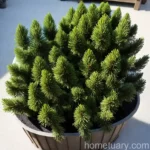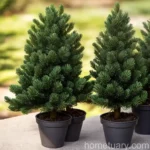Norway Spruce (Picea abies ‘Pendula’): A Comprehensive Guide
The Norway spruce, scientifically known as Picea abies, is an elegant and graceful conifer that belongs to the Pinaceae family. Its variety Pendula is particularly sought after for its stunning weeping growth habit. In this comprehensive guide, we will delve into the characteristics, cultivation tips, maintenance advice, as well as interesting facts and historical significance of the Norway spruce (Picea abies ‘Pendula’). Whether you are a professional landscaper, a homeowner, or simply an admirer of trees and plants, this guide aims to provide valuable insights into this captivating species.
What is a Plant: Norway Spruce (Picea abies ‘Pendula’)
The Norway spruce (Picea abies) is a large, evergreen conifer native to northern and central Europe. The species is known for its iconic pyramidal shape and long, sweeping branches covered in dark green needles. The Pendula variety, in particular, exhibits a graceful weeping form, adding to its allure as a landscaping focal point.
Key Takeaways – Norway Spruce (Picea abies ‘Pendula’)
- Characteristics: The Norway spruce (Picea abies ‘Pendula’) is characterized by its weeping growth habit, dark green needles, and elegant form.
- Cultivation: It thrives in moist, well-drained soil and prefers full sun to partial shade.
- Uses: Widely used in landscaping as a focal point or specimen tree due to its ornamental qualities.
- Water: Moderate water needs, especially during establishment and dry periods.
- Sunlight: Prefers full sun to partial shade.
- Fertilizer: Generally low maintenance, but benefits from a balanced fertilizer in early spring.
- Soil: Thrives in well-drained, acidic soil with good organic content.
- Pruning: Limited pruning required; primarily to remove dead or damaged branches.
- Propagation: Can be propagated from cuttings or grafting.
- Container Popularity: Not commonly grown in containers due to its size, but dwarf cultivars may be suitable.
- Common Diseases: Susceptible to some fungal diseases and pests, which can be managed through proper care and maintenance.
- Botanist’s Tips: Regular inspection and prompt attention to any signs of stress or disease are essential for maintaining the health of this species.
- Fun Facts: The Norway spruce has a rich cultural and historical significance, and its timber is valuable in various industries.
Now, let’s delve deeper into each of these aspects to gain a comprehensive understanding of this captivating conifer.
Norway Spruce (Picea abies ‘Pendula’) Characteristics
The Norway spruce (Picea abies ‘Pendula’) possesses several distinct features that set it apart in the world of conifers.
Norway Spruce Characteristics
- Weeping Growth Habit: The ‘Pendula’ variety is characterized by its graceful, weeping form, with long, pendulous branches that create an elegant silhouette. This unique growth habit makes it a standout specimen in any landscape.
- Needles: The species sports dark green needles that are sharply pointed and borne singly around the branches. These needles provide a dense, evergreen canopy that offers both visual appeal and year-round privacy when used as a screen or windbreak.
- Size and Height: In its natural habitat, the Norway spruce can reach towering heights of 60-200 feet, with a spread of 25-30 feet. However, the ‘Pendula’ variety typically demonstrates a more modest size, making it suitable for smaller residential landscapes.
Picea abies ‘Pendula’ Description
- Bark Texture: The bark of the Norway spruce is reddish-brown and becomes deeply furrowed as the tree matures, adding to its rugged and picturesque appearance.
- Needle Structure: Each needle is approximately 1 inch long, glossy dark green, and arranged in a spiral pattern around the stem.
Norway Spruce Varieties
- ‘Pendula’: The ‘Pendula’ variety is renowned for its weeping form and is commonly used as a focal point in landscape design. Its cascading branches make it an eye-catching addition to any garden or park setting.
Picea abies ‘Pendula’ Growth Habit
- Graceful Form: The ‘Pendula’ variety exhibits a distinctive pendulous growth habit, with its branches gracefully drooping towards the ground. This growth pattern adds a sense of elegance and motion to the tree, making it an ideal choice for creating a focal point in a garden or landscape.
Norway Spruce (Picea abies ‘Pendula’) Cultivation Tips
Successful cultivation of the Norway spruce (Picea abies ‘Pendula’) hinges on providing the right growing conditions and care. Let’s explore the essential factors to consider when cultivating this captivating conifer.
Norway Spruce Water Needs
- Watering: Newly planted Norway spruces require regular watering to ensure establishment. Once established, they generally have moderate water needs but benefit from additional watering during dry spells, especially in the summer months. Proper irrigation is crucial for the health and vigor of the tree, particularly during the first few years after planting.
Picea abies ‘Pendula’ Sunlight Requirements
- Sun Exposure: The Norway spruce thrives in full sun to partial shade. While it can tolerate some shade, it generally performs best when provided with ample sunlight to promote healthy growth and the development of its characteristic dense canopy.
Norway Spruce Fertilizer
- Fertilization: This species is relatively low maintenance and typically does not require frequent fertilization. However, applying a balanced, slow-release fertilizer in early spring can provide the tree with essential nutrients to support healthy growth and vigor.
Soil Requirements
- Soil Type: The Norway spruce prefers moist, well-drained soils that are slightly acidic (pH 5.0-6.5). It is important to ensure that the soil has good organic content to support the tree’s growth and overall health.
Norway Spruce Pruning Techniques
- Pruning: The ‘Pendula’ variety generally requires minimal pruning. Pruning should be limited to the removal of dead, damaged, or overcrowded branches to maintain an open and attractive form. It’s important to exercise caution when pruning to preserve the tree’s natural weeping shape.
Picea abies ‘Pendula’ Propagation Methods
- Propagation: Norway spruces can be propagated from softwood cuttings taken in early summer or from grafting onto rootstock. Propagation from cuttings is an effective method for producing new trees that retain the desired traits of the parent plant.
Norway Spruce Landscape Uses
- Landscape Design: The Norway spruce, particularly the ‘Pendula’ variety, is highly valued for its ornamental qualities and is often used as a specimen tree in gardens, parks, and larger landscapes. Its graceful form and weeping branches make it a captivating focal point in any setting.
Picea abies ‘Pendula’ Care Guide
Proper care is essential for maintaining the health and vigor of the Norway spruce (Picea abies ‘Pendula’). Let’s delve into the essential maintenance tips to ensure the long-term well-being of this exceptional conifer.
Norway Spruce Planting Instructions
- Planting Depth: When planting a Norway spruce, it is important to ensure that the root collar is level with the soil surface. Proper planting depth is crucial for the establishment and long-term health of the tree.
Picea abies ‘Pendula’ Maintenance Tips
- Regular Inspection: Regularly inspect the tree for signs of stress, disease, or pest infestations. Early detection and prompt intervention can help mitigate potential issues and preserve the health of the tree.
Norway Spruce Diseases and Pests
- Common Diseases: The Norway spruce is susceptible to certain fungal diseases such as needle cast and root rot. Maintaining good air circulation and avoiding overhead watering can help prevent these issues. Additionally, pests such as spruce spider mites and adelgids can pose a threat to the tree’s health and require appropriate management strategies.
Picea abies ‘Pendula’ Hardiness Zones
- Hardiness Zones: The Norway spruce is well-suited to USDA Hardiness Zones 2-7, exhibiting strong adaptability to cold climates and winter conditions.
Norway Spruce Climate Preferences
- Climate Tolerance: The Norway spruce thrives in cool temperate climates with well-defined seasons. It exhibits excellent cold hardiness and is well-suited to regions with harsh winters.
Picea abies ‘Pendula’ Soil Requirements
- Soil pH Tolerance: The tree prefers slightly acidic soil with a pH range of 5.0-6.5. Maintaining proper soil pH is essential for ensuring optimal nutrient uptake and overall health.
Norway Spruce (Picea abies ‘Pendula’) Interesting Facts
The Norway spruce (Picea abies ‘Pendula’) is not only revered for its aesthetic appeal and ornamental value but also holds cultural, historical, and ecological significance. Let’s explore some intriguing and noteworthy facts about this remarkable tree.
Norway Spruce Wildlife Interactions
- Ecological Role: The Norway spruce serves as a valuable habitat and food source for various wildlife species. It provides shelter for birds and small mammals and contributes to the overall biodiversity of forest ecosystems.
Picea abies ‘Pendula’ Timber Uses
- Commercial Value: The wood of the Norway spruce is highly prized for its versatile applications. It is used in construction, furniture-making, and paper production, among other industries. The timber exhibits desirable qualities such as straight grain, workability, and resilience.
Norway Spruce Medicinal Properties
- Traditional Uses: In traditional medicine, various parts of the Norway spruce, including the resin and needles, have been used to prepare remedies for respiratory ailments and skin conditions. The tree holds a place in folklore and traditional healing practices.
Picea abies ‘Pendula’ Folklore and Mythology
- Cultural References: The Norway spruce features prominently in folklore and mythology, often symbolizing resilience, longevity, and protection. Its enduring presence in cultural narratives reflects its deep-rooted significance in human history.
Conclusion
In conclusion, the Norway spruce (Picea abies ‘Pendula’) is a captivating and esteemed member of the conifer family, renowned for its striking appearance, versatile uses, and rich cultural significance. Whether adorning a landscape as a focal point, providing valuable timber resources, or inspiring traditional folklore, this remarkable species continues to captivate and enrich our natural and cultural landscapes.
By gaining a deeper understanding of the characteristics, cultivation tips, maintenance advice, and fascinating facts surrounding the Norway spruce, we can better appreciate and steward this iconic tree, ensuring its enduring presence in our natural and cultural heritage.
We hope this comprehensive guide has provided valuable insights into the world of Norway spruce (Picea abies ‘Pendula’), inspiring a deeper appreciation for its beauty and significance.
References
- Royal Horticultural Society – Norway Spruce
- USDA Forest Service – Picea abies ‘Pendula’
- Missouri Botanical Garden – Picea abies
- North Carolina State University – Norway Spruce
This marks the end of my comprehensive guide on the captivating Norway spruce (Picea abies ‘Pendula’). I hope you found this guide informative and inspiring. Should you have any further questions or seek additional information, please do not hesitate to refer to the references provided or reach out to local horticultural professionals for personalized guidance on cultivating and caring for this remarkable species.
This blog post is intended for informational purposes only. The information provided is based on the current understanding of the topic and is intended to provide general guidance. As with any horticultural endeavor, it is essential to conduct thorough research and seek advice from qualified professionals to ensure the best outcomes for your specific circumstances.















